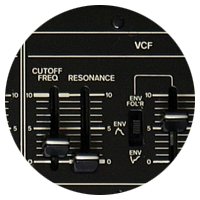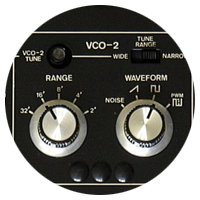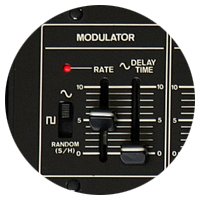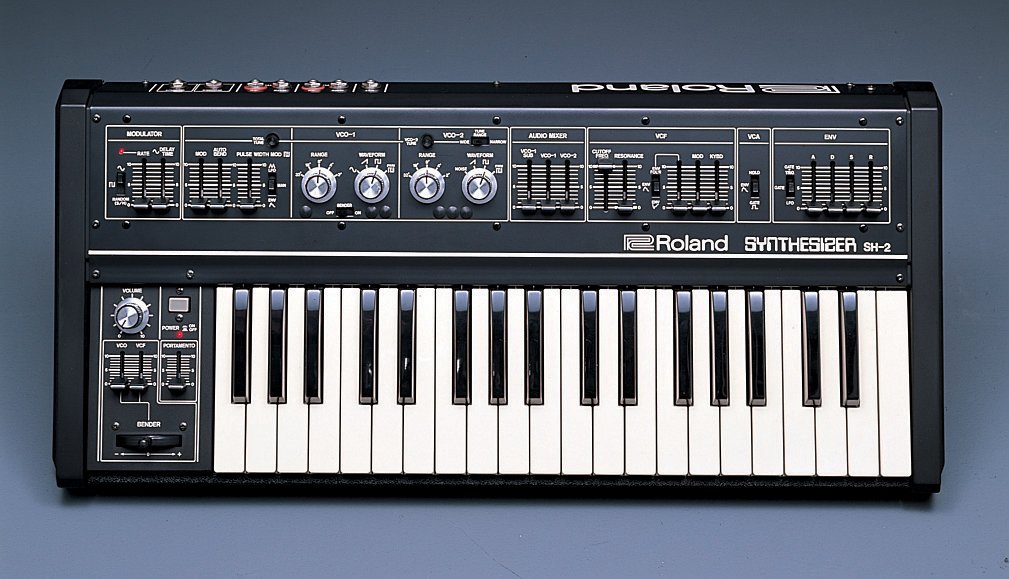![]()
The Roland Icon Series is a collection of articles looking back at the most popular and recognised Roland instruments. In over four decades, Roland has designed many world-first instruments like the first touch-sensitive keyboard and first guitar synthesizer. This article looks at the classic SH-2 Synthesizer.
Roland has also made many instruments that have influenced countless musicians, bands and artists, and defined a number of musical genres.
This first article in the Roland Icon Series looked back on the classic Roland SH-101 synthesizer. Let’s head back to 1979 and the launch of the SH-2 Monophonic Synthesizer.
In the late 1970s, synthesizers were undergoing a significant transition with the development of polyphony and tone memory. As the world’s synthesizer manufacturers raced to develop these new technologies, Roland launched a seemingly basic monophonic synthesizer – the now classic SH-2.
Although it was released around the same time as Roland’s JUPITER-4, a pioneer of polyphonic synthesizers, the SH-2’s functionality was rather conservative compared to that of the JUPITER-4. But its uniquely designed configuration – which consisted of two voltage-controlled oscillators (VCOs) and a sub-oscillator that essentially gave it three VCOs – was capable of extremely fat and warm analog synth tones. To this day, many synth aficionados feel it produces the most earth-shaking, bone-rattling synth bass sounds of all time.
THE NUMBER “2” IN SH-2 IS FOR DUAL OSCILLATOR

The Roland SH-2 is a monophonic synthesizer (or monosynth) meaning it plays one note at a time making it ideal for bass lines, leads and arpeggios. Unlike the SH-101, the SH-2 is a dual oscillator synth with a third square-wave sub oscillator – each sound blended via the AUDIO MIXER section.
Let’s take a look at the two voltage-controlled oscillators.
VCO-1 and VCO-2 have independent TUNE RANGE SWITCH and WAVEFORM SELECTOR controls with VCO-2 having a TUNE CONTROL knob that really makes lead sounds cut through the mix. The TUNE CONTROL really adds some punch to leads and we will discuss this in the next section.
The SH-2 has a total of five waveforms available across the two VCOs: SINE, SAWTOOTH, SQUARE, PULSE-WIDTH and NOISE. Using these waveforms, individually or mixed, provides a HUGE number of tones. By understanding each of the waveforms, you can design any sound you wish.
This is where the SH-2 really shines! The waveforms available, and the options for modulation (how you can make the sound move) make it a powerhouse monophonic synth. Monosynths tend to be favoured for lead and bass sounds, but the SH-2 can also make some fantastic “random” sounds, percussion tones and sound effects too!
TOP FIVE SYNTHESIS SOUNDS OF THE SH-2
The Roland SH-2 is an exceptional flexible instrument capable of a wide range of sounds from smooth and gentle to brutal and aggressive. An experienced synthesist is able to pull any number of “instrument” sounds out of this monosynth beast! Traditional instruments like flutes and trumpets to synthesised instruments like analog kick drums, ripping “zipper” leads and throbbing basses are all hidden among the knobs and sliders. This versatility makes the SH-2 a handy synth for both the stage and the studio.
Here they are! Five classic synth sounds hidden in the SH-2:
1. SQUARE WAVE BASS
Tuning the VCOs to 32′ and 16′ on the TUNE RANGE SWITCH will get you well into the bass zone! Like the classic Roland TB-303, the SH-2 has a square wave that can really add some punch to your bass lines. But it’s the addition of the square wave sub-oscillator that will really get the walls shaking!
Whenever playing around with bass sounds, make sure you experiment with the voltage-controlled filter (VCF). The VCF is a 24 dB/octave low-pass filter meaning it allows bass frequencies to pass through and cuts off high frequencies. The filter allows you to “roll off” the brighter edge of the square wave (via CUTOFF FREQUENCY) and really adds a deep, rich dimension to your bass line. Adding some RESONANCE will give that bottom end more oomph too!
2. DETUNED LEAD
What makes a classic lead sound?
First, the ability to “stack” oscillators and mix them creates a complex waveform that is rich in harmonics to help your lead line rip through the mix. Second, “you will want to “detune” one oscillator (like VCO-2 with the TUNE CONTROL trimmer). By making one VCO slightly sharper or flatter by a few cents will give you a thicker, chorusing sound. Finally, you will want to “modulate” the oscillator. By using the MODULATOR section, you can “move” the pitch of the oscillator for a vibrato effect or the pulse width (Pulse Width Modulation) for a dynamic lead tone.
The SH-2 can do all of the above and these features make up a big part of why the SH-2 is a classic synth lead machine.
3. RANDOM (SAMPLE & HOLD)
If you’ve been looking to add something unique and dynamic to your track, you should think about adding a random modulating element like Sample & Hold (S/H). The MODULATOR section features a RANDOM (S/H) waveform that can be used to modulate the tone and pitch of the synthesizer for some really unique effects.
A classic S/H effect is to modulate the resonance of the VCF (VCF MOD) with the resonance set at a high level. A series of random pitches from the filter will be heard in parallel with the VCO synth tone without disrupting its pitch or tone.
The S/H can also modulate the VCA to produce random pulses of the synthesised sound. Pull up a bass tone and set the LFO to modulate the VCA for a rhythmic change in amplitude. Pitch won’t be effected and this can be a really powerful driving element when synced with your drum track.
4. PERCUSSION
There are two features of the SH-2 that make percussion sounds a breeze. By manipulating the VCF, playing with the NOISE waveform of VCO-2 and using the GATE and TRIGGER ENVELOPE mode of the VCA, you can generate any piece of the drum kit. Kick, snares, hats, cymbals sounds are all at your disposal – here’s how you can do it.
The VCF has the ability to self-oscillate, i.e. the filter can produce a pure sine wave with the RESONANCE turned up. When the CUTOFF is turned down, the lower end of the frequency range is emphasised – great for sub-octave bass sounds. By using GATE/TRIGGER mode, you can play the keyboard for a kick drum sound.
Using the NOISE waveform in VCO-2 in the same manner as above can get you tight hats, snappy snares and long-decaying cymbals. The power in percussion sounds comes from the ADSR ENVELOPE so experiment with the envelope for access to a wide range of percussion tones.
5. EFX
Using a combination of percussion and random sounds can generate a number of sound effects that make for a great intro or breakdown. By combining some of the techniques from above you can generate effects such as sweeping winds, chirping birds, whistles – it’s all up to your imagination!
A classic sound effect is the bleeps and bloops of 60’s sci-fi films – a sound used to represent computers or robots. This sound is iconic to synthesizers of old and the SH-2 is no exception! To get this sound, you will want to modulate the VCO-1 (set to SINE) with the RANDOM (S/H). Add a bit of reverb and you have instant space sounds that will bring back instant memories of your favourite 60s film and TV scores.
https://www.roland.com/au/products/rc_sh-2/
Now you can have the SH-2 on your computer with Roland Cloud!
The New SH-2
With the new SH-2 Synthesizer VSTi from Roland Cloud, you get a total reproduction of the classic SH-2 Synthesizer from 1979. Renowned for its raw vintage tone, the SH-2’s dual VCO plus sub oscillator configuration dishes out devastatingly fat basses, edgy leads, and wild effects. Designed for Mac or PC hosts, the new SH-2 uses Analog Circuit Behaviour technology to faithfully recreate the warm, rich sound of the original with a level of authenticity that can only come from Roland.
The SH-2 PLUG-OUT Software Synthesizer is an incredibly precise recreation that leverages Roland’s decades-old expertise and deep knowledge of the original analogue units. Like other products in the AIRA series, this new SH-2 uses Analog Circuit Behaviour (ACB) technology to faithfully capture the fine details of the SH-2’s sound, right down to the behaviour and interaction of the individual analogue circuits.
Everything has been reproduced exactly, from the VCF which is capable of self-oscillation to the attack and long decay characteristics of the steep envelope. The unique harmonic makeup and pitch wavering are present as are the complex interactions between parameters that result from the original analogue circuit design. Even behaviours that occur only in analogue circuitry are accurately reproduced, like the subtle effect on tonality when the user tweaks parameters unrelated to the actual tone being produced.
There are even some new features that were not available on the original. This new SH-2 has a VCO range that is expandable to 64′, two envelopes, reverb, delay and crusher effects, Autobend with support for reverse actions, and a tempo-syncable arpeggiator.
There are over 50 Roland virtual instruments available to you and you can also embrace the future with the new ZENOLOGY plug in. Share your sounds across software and hardware with the ZEN-Core Synthesis System. Also, keep your music fresh with genre-specific patches, patterns, and sound packs. There is a choice of membership tiers including free. Click here to find out more about Roland Cloud.
RELATED ARTICLES
Roland Icon Series: The System 100 Synthesizer
Roland Icon Series: The SH-101 Synthesizer
Roland Icon Series: The Promars Synthesizer
Roland Icon Series: The Jupiter-8 Synthesizer
Roland Icon Series: The Juno-106 Synthesizer
Roland Icon Series: The D-50 Linear Synthesizer
Roland Synth Chronicle: 1973 through 2013
The A-to-Z of Synthesizer Terms
Synthwave, SCI FI and Sound Design



